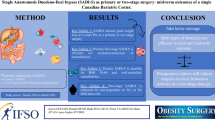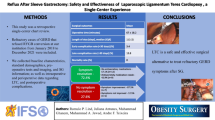Abstract
In children, the indications for oesophageal substitution are principally, long gap oesophageal atresia (OA), severe anastomotic disruption following primary repair of OA and severe caustic or peptic strictures. We present an outcome review of eight cases who underwent oesophageal substitution with jejunum at our institution between 1986 and 2001. The purpose of this study was to evaluate our experience with free/pedicled jejunal grafts and its long-term outcome as an oesophageal substitute. Operative and postoperative outcome with free and pedicled jejunal grafts in four cases of pure OA, two cases of OA and distal tracheo-oesophageal fistula (TOF), one patient with a high retrolaryngeal oesophageal web and one case of severe caustic oesophageal stricture. Six patients had an oesophagostomy and a gastrostomy fashioned previously. Eleven free jejunal grafts were performed in six patients (three intraoperative redo interpositions for immediate graft loss, three separate grafts in one patient and two free grafts in two patients). One patient’s pedicled jejunal graft proximally required microvascular anastomosis while the other had a pedicled graft without microvascular anastomosis. Early postoperative complications included four upper anastomotic leaks (three free grafts, one pedicled with microvascular support), pneumothorax requiring prolonged ventilation and Horner’s syndrome. Recurrent laryngeal nerve injury occurred in the patient who had a high retrolaryngeal oesophageal web. During follow up (5–18 years) late complications of upper anastomotic stricture in four patients and graft redundancy with subsequent kinking of the lower anastomosis were observed in one patient. Three patients established a complete oral diet; a further three patients relied on supplemental gastrostomy feeds and one patient is entirely gastrostomy fed. There were two late deaths, one from aspiration and the other from a severe asthmatic attack (5 and 7 months postoperatively, respectively). Our results indicate that there are significant complications related to the use of free jejunal grafts. Early recognition and treatment are of paramount importance in the ultimate achievement of a successful technical outcome.

Similar content being viewed by others
References
Jezioro Z, Kus H (1958) Experiences with the retrosternal esophageal replacement employing jejunum or ileum. J Pediatr Surg 44:275
Ring WS, Varco RL, L’Heureux PR et al (1982) Esophageal replacement with jejunum in children. J Thorac Cardiovasc Surg 83:918–927
Saeki M, Tsuchida Y, Ogata T et al (1988) Long-term results of jejunal replacement of the esophagus. J Pediatr Surg 23:483–489
Jones BM, Gustavson EH (1983) Free jejunal transfer for reconstruction of the cervical oesophagus in children: a report of two cases. Br J Plast Surg 36:162–167
Cusick EL, Batchelor AA, Spicer RD (1993) Development of a technique for jejunal interposition in long-gap esophageal atresia. J Pediatr Surg 28:990–994
Dunn JC, Fonkalsrud EW, Applebaum H et al (1999) Reoperation after esophageal replacement in childhood. J Pediatr Surg 34:1630–1632
Saitua F, Madrid A, Capdeville F et al (2004) Pharyngo-esophageal reconstruction by free jejunal graft and microvascular anastomosis in a 10-year old girl. J Pediatr Surg 39(7):e10–e12
Simms MH, Brearley S, Watson D, Roberts KD (1989) Reconstruction of the esophagus using a free jejunal graft in complicated esophageal atresia. Ped Surg Int 4:159–161
Freeman NV, Cass DT (1982) Colon interposition: a modification of the Waterston technique using the normal esophageal route. J Pediatr Surg 17:17–21
Anderson KD, Randolph JG (1970) Gastric tube interposition: a satisfactory alternative to the colon for esophageal replacement in children. Ann Thorac Surg 25:521–525
Marujo WC, Tannuri U, Maksoud JG (1991) Total gastric transposition: an alternative to esophageal replacement in children. J Pediatr Surg 26:676–681
Davenport M, Hosie GP, Tasker RC et al (1996) The long term effects of gastric transposition in children: a physiological study. J Pediatr Surg 31:588–593
Meyers WC, Seigler HF, Hanks JB et al (1980) Postoperative function of “free” jejunal transplants for replacement of the cervical esophagus. Ann Surg 192:439–450
Hanna EA, Harrison AW, Derrick JE (1967) Comparative function of visceral esophageal substitutes by cinefluoroscopy. Ann Thorac Surg 3:173–176
Rodgers BM, Talbert JL, Moazam F et al (1978) Functional and metabolic evaluation of colon replacement of the esophagus in children. J Pediatr Surg 13:35–39
Dave KS, Holden GH, Holden MP et al (1972) Esophageal replacement with jejunum for non-malignant lesions. Surgery 72:466–473
Oniscu GC, Walker WS, Sanderson R (2001) Functional results following pharyngolaryngooesophagectomy with free jejunal graft reconstruction. Eur J Cardiothorac Surg 19:406–410
Romeo G, Zuccarello B, Proietto F et al (1987) Disorders of the esophageal motor activity in atresia of the esophagus. J Pediatr Surg 22(2):120–124
Author information
Authors and Affiliations
Corresponding author
Rights and permissions
About this article
Cite this article
Cauchi, J.A., Buick, R.G., Gornall, P. et al. Oesophageal substitution with free and pedicled jejunum: short- and long-term outcomes. Pediatr Surg Int 23, 11–19 (2007). https://doi.org/10.1007/s00383-006-1770-0
Accepted:
Published:
Issue Date:
DOI: https://doi.org/10.1007/s00383-006-1770-0




